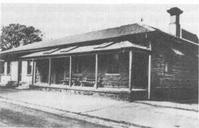


Chapter 13
I Colonial Origins
II First World War
III Between The World Wars
IV The Second World War
V Post-second World War
VI After The Joint Project
VII Science And Decisions At The Top
VIII Armed Services Technology
IX New Tasks And Projects
X Transfer Of Research And Development
XI Acknowledgement
References
Index
Search
Help
Contact us

In the short period between the formation of the Commonwealth of Australia and the outbreak of the First World War, the Government made considerable progress towards developing a munitions industry. Hake's services were made available to the Commonwealth Government and his cordite investigations in England indicated that deterioration of this material under the conditions of elevated temperature and humidity, such as could be expected in Australia, was a significant factor. The manufacture of cordite in Australia under Government control resulted from Hake's recommendation that the product manufactured by the Royal Gunpowder Factory at Waltham Abbey be preferred to offerings by commercial firms. He attributed the superiority of its product to good quality control, which prevented the inclusion of impurities which hastened deterioration at elevated temperature. A Cordite Factory was erected at Maribyrnong, Victoria close to the Colonial Ammunition Factory following appropriation of land in 1908.
Probably the first attempt at scientific inquiry into munitions operation problems occurred under Hake's guidance when, with Dr Thomas Lyle, Professor of Natural Philosophy at Melbourne University, they carried out experiments to prove his theory that the bursting of 0.303 inch magazine rifles was not caused by defective composition of ammunition from the Colonial Ammunition Company. Their examination showed that 'double bulleting' was possible with automatic machines and that closer quality control could eliminate the problem.
Another of Hake's recommendations concerning the setting up of explosives manufacture in Australia and accepted by the Commonwealth Government was the need to create an independent authority for the inspection and maintenance of the quality of explosive materials. He was appointed Inspector of Explosives in 1907 and continued to act as Chemical Adviser to the Government. Marcus Bell was appointed as his assistant and succeeded him in the position when Hake retired in 1911. As considerable stocks of explosives were held throughout Australia -mostly for military purposes -Hake set up a testing laboratory at Victoria Barracks to check the state of preservation of these stocks, some of which had been held for over ten years. He reported that only ten per cent had deteriorated beyond acceptable limits and would have to be destroyed. These were held mostly in Queensland.

The manufacture of explosives and propellants was begun at the Cordite Factory in 1912. Mr A. E. Leighton was appointed Manager; he was a Waltham Abbey man who had been responsible for raising the Aruvan Kadu factory in India to a high standard of efficiency. He was to play a visible role in the eventual establishment of a munitions industry in Australia on a firm footing.
The next step in munitions manufacture was the production of rifles. Commander W. Clarkson was sent to England in 1908 to look into their manufacture and a Small Arms Factory was opened at Lithgow, New South Wales in 1912, in close proximity to coal supplies for power and to an iron works. The repetition manufacturing technique of Pratt and Whitney in the United States of America was chosen in preference to the processes employed in the United Kingdom and a 50 per cent improvement in the man-hour rate over that achieved in the latter country for manufacture of the same rifle resulted from this advanced technology.
Organisations in Australian Science at Work - Colonial Ammunition Factory; Royal Gunpowder Factory; Small Arms Factory
People in Bright Sparcs - Bell, Marcus; Clarkson, Commander W.; Leighton, A. E.; Lyle, Dr Thomas
 |
Australian Academy of Technological Sciences and Engineering |  |
© 1988 Print Edition pages 920 - 921, Online Edition 2000
Published by Australian Science and Technology Heritage Centre, using the Web Academic Resource Publisher
http://www.austehc.unimelb.edu.au/tia/901.html